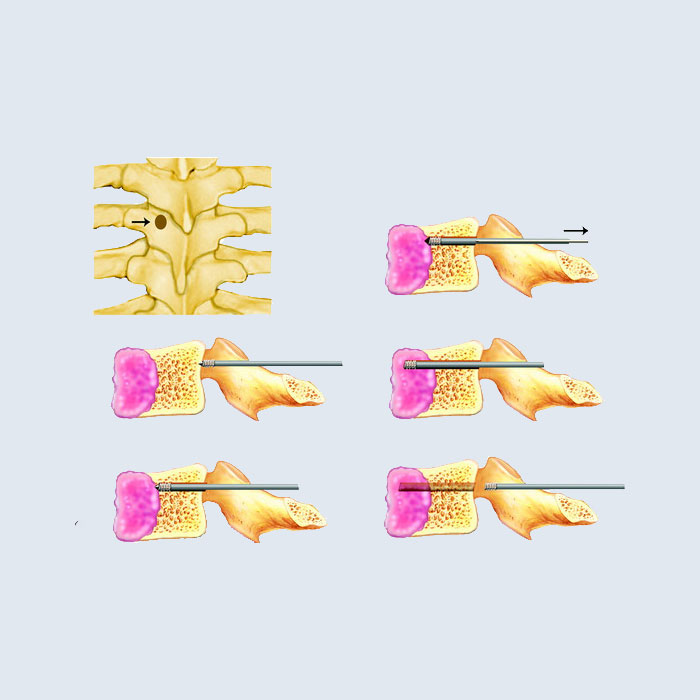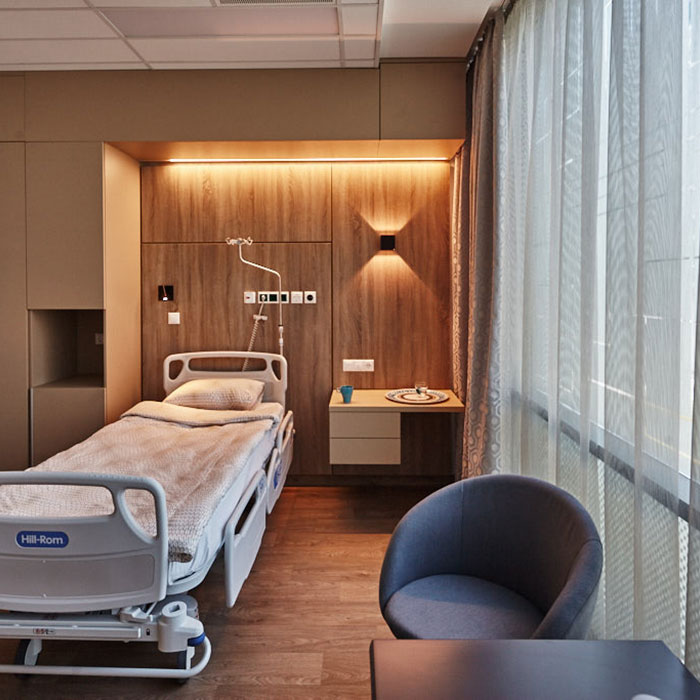Vertebral biopsy
During vertebral biopsy, the abnormally rebuilt vertebra is sampled under surgical conditions.
What can cause abnormal reconstruction of the vertebrae?
Abnormal reconstruction of the vertebrae can be caused by several factors. It can be caused by osteoporosis, which also affects the structure of the vertebrae, a primary or secondary metastasis to the spine, a fracture, genetic causes, or inflammation.
To determine the cause of the reconstruction, in addition to imaging examinations (MRI, CT), histological sampling and vertebral biopsy are required knowing the medical history.
What are the symptoms of vertebral reconstruction?
In the case of abnormal reconstruction of the vertebrae, the most common symptom is local pain, which occurs under strain and often persists even when rested.
Possible fracture of the vertebrae can cause deformity of the spine as well as compression of the nerve elements. The latter can lead to limb clumsiness, incoordination, weakening and paralysis of innervated muscles, inability to urinate and defecate, impotence in men, and pain radiating along the nerves and various sensory deficits. Depending on which part of the spine is affected, the listed symptoms may occur on the upper or lower limbs or on the torso.
When is vertebral biopsy warranted?
Vertebral biopsy may be warranted if the exact cause of the abnormal reconstruction of the vertebrae is unclear.
Histological sampling can be used to confirm or determine the type of tumour, and in the case of inflammatory diseases, a culture sample can be obtained from the spine or the adjacent abscess.

What happens during vertebral biopsy?
During the operation, the sampling work “canal” is introduced into the vertebra through a small (3-5 mm) incision. To introduce the work “canal”, the surgeon inserts a piercing device called needle into the vertebra with image intensification (X-ray) targeting, and then removes a staple wire that ends in the vertebral body by removing its inner conductive stem. The surgeon then pulls off the sleeve of the piercing device called the needle from the staple wire, and then pulls the work “canal” onto the wire. The work “canal” is essentially a tube with a thicker pen diameter. The sample is taken through the tube.
Following histological sampling, the weakened vertebral body can be filled with “bone cement” as needed to stabilize the structure. Filling with “bone cement,” or vertebroplasty, may be necessary to prevent the weakened structure of the vertebra from collapsing, which can occur under much less strain than in the case of a healthy vertebra.
If filling is carried out as well with “bone cement”, the material called Polymethylmethacrylate (PMMA) used as bone cement is loaded through the same work “canal” through which the sampling took place. PMMA does not decompose, does not rebuild, only fills gaps.
What are the risks of the intervention?
As with any medical intervention, vertebral biopsy can have dangers and complications. In the case of a previously operated spine, the risk is higher.
During the procedure, the needle or K wire can cause injuries: it can damage the spinal cord in the spinal canal, nerve roots in the root canal, large blood vessels along the spine, the walls of the chest in the thoracic section, and the lungs, which can cause breathing problems.
What can I expect after the procedure?
After vertebral biopsy, in a complication-free case, you can get up after the procedure, depending on your condition, you can leave our Hospital the same day or the next day.
If an early complication does not develop, the sutures are removed after 1 week, therefore it is not recommended to wash the affected area. You can bathe and swim when the suture no longer covers the wound line, the wound is completely healed, i.e. a scar is visible.
From the day of surgery until full mobility is achieved, injection therapy (thrombosis prophylaxis) is required to prevent thrombosis, which patients are taught to administer.
Gradual physiotherapy is recommended for a few weeks after the operation sparing the spine.
What can happen if the intervention does not take place?
If sampling of the vertebra in question is not performed, an accurate diagnosis cannot be made, which prevents the selection of the appropriate treatment, and further deterioration may occur.
What is included in the price of the vertebral biopsy at Medicover Hospital?
The price of the vertebral biopsy includes the cost of the procedure, as well as the cost of hospital stay after surgery and a follow-up examination.
The price of the preliminary specialist consultation and the pre-operative examinations is not part of the surgical cost, please inquire about the cost of these from our Call Center.

Convenience services
We accommodate our clients in a modern, pleasant, air-conditioned single room. Each room has its own bathroom, refrigerator, and TV as well as free WIFI. We also provide our clients with individual nurse supervision, who will help your continuous recovery during your stay.
